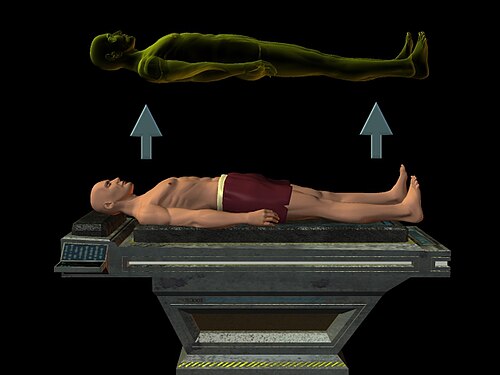瀕死體驗

瀕死體驗(粵音:pan4 sei2 tai2 jim6;譯自英文:near-death experience,NDE)係一種人瀕臨死亡嗰時經常會有嘅體驗。自從近代醫學興起,有好多醫護人員都發現死過返生嘅病人會報告話自己經歷過一種超常體驗,呢種體驗俾人稱之為 NDE。一段典型嘅 NDE 過程如下:
- 經歷 NDE 嘅病人因為受咗好重嘅傷(例如嚴重嘅撞車事故),或者有致命性嘅病發作(例如心臟驟停)而接近死亡;
- 事實係,個病人直頭心跳停咗,而且個腦停止咗活動-醫學上算經已死咗,但多得醫護人員全力搶救,個病人最後救得返;
- 事後個病人會話自己喺死咗嗰段期間經歷過奇怪嘅經驗,話自己見到自己靈魂離開身體,經過一條盡頭有光嘅隧道,跟住仲見到耶穌等嘅宗教人物或者過咗身嘅親友嘅靈魂;而且有啲病人仲話 NDE 期間見到醫護人員搶救佢哋令佢哋返生,甚至能夠準確噉講返出醫護人員喺嗰段期間做嘅嘢[3]。
世界各地嘅人-無論文化同宗教-都有可能經歷 NDE。NDE 呢個神秘嘅現象吸引咗醫學、心理學同腦神經學等領域嘅科學家嘅興趣[4][5]。
NDE 引起咗廣泛辯論:一方面,有唔少人視 NDE 為死後生命存在嘅證據[6];而另一方面,科學界又有嘗試諗可唔可以用一個唔涉及死後生命嘅假說解釋 NDE,例如有好多腦神經學家認為,NDE 源於一個就快死、缺氧嘅腦產生嘅幻覺,不過直至廿一世紀初為止,呢啲純腦神經學性質嘅假說並唔完全受科學證據支撐。所以對於 NDE 點解存在,科學界依然係眾說紛紜[7][8]。
詞源
[編輯]類似瀕死體驗嘅體驗喺人類史早期經已存在[9],但呢種體驗要去到 1890 年代初先至引起學界注意。當時有心理學家研究一啲差啲冇命嘅人嘅體驗-呢啲人可能由高處跌落嚟、差啲浸死、上陣打仗... 等等,但最後大難不死。心理學家發現咗 NDE 呢種神秘現象,而當時法國心理學家兼知識論家維特·易加[歐 1]將呢種體驗命名做
正式開展咗心理學界對瀕死體驗嘅研究[11][12][13]。
Near-death experience 呢隻英文詞係喺 1970 年代固定嘅:喺 1968 年,英國作家絲莉亞·格連[歐 2]出咗本書,紀錄 400 個人對佢哋嘅靈魂出竅經歷嘅描述,令英文圈嘅人對瀕死體驗開始有廣泛嘅討論[14];喺 1969 年,瑞士出世嘅美國精神醫學專家伊莉莎伯·曲伯羅斯[歐 3]又出咗書,嘗試解釋瀕死體驗嘅現象,引起咗學界嘅迴響。而打後去到 1975 年,美國精神醫學專家利民·穆迪[歐 4]正式用咗
- near-death experience
-直譯做粵文係就嚟死體驗噉解。呢隻詞嚟討論瀕死體驗嘅現象,令呢隻詞廣傳,而佢呢個嗌法一路俾人沿用至今[12][15]。
概論
[編輯]共通特徵
[編輯]
根據 NDE 研究,唔同人經歷嘅 NDE 有好多共同特徵[4]。精神醫學專家布魯斯·格里臣[歐 5]指出,NDE 一般有覺得自己靈魂出竅、見到過咗身嘅親人同宗教人物、以及感覺超越咗個人界限等嘅特徵[12][16]。個人對呢啲體驗嘅了解可能會隨文化同宗教而有異,但個體驗都仲係好似:例如喺以基督教背景做主流嘅美國,多數人會將「NDE 嗰陣遇到嘅靈體」稱為耶穌或者天使,而印度教嘅信徒就比較傾向將呢啲靈體稱之為死神嘅使者-兩者共通點在於,喺 NDE 期間個人會遇到一啲「靈體」[17][18]。
- 意識到自己經已死咗,
- 覺得自己離開咗世界,不過
- 感到平安同唔覺得痛,情緒上偏向正面。
- 靈魂出竅[歐 6],意識到自己處於身體嘅外面,有陣時仲會見到醫護人員喺度全力搶救佢哋嘅樣。
- 隧道體驗[歐 7]-覺得自己升緊天,或者通過一條黑暗嘅隧道。
- 急速噉移向一道光,見到一個光靈或者光存在體[歐 8],個光靈同經歷 NDE 嘅人溝通-呢個光靈成日俾經歷 NDE 嘅人稱為「上帝」[21]。
- 感覺到(嚟自光靈)無條件嘅愛同接納[22]。
- 遇到若干個光靈或者著住白衫嘅靈(成日俾人描述為天使),又有啲 NDE 經歷者會遇到過咗身嘅親友嘅靈魂,而呢啲靈魂講一啲佢哋理應唔知嘅嘢俾佢哋聽。
- 人生審視[歐 9]-一剎那間重新睇返自己人生經歷過嘅一切。
- 自己或者身邊嘅光靈決定自己應該返去人世,好多時個人會覺得唔想返去。
- 最後感覺到自己突然間返咗入去自己嘅身體嗰度[23]。
階段
[編輯]根據心理學家肯尼·靈[歐 10],NDE 可以分做五個階段[24]:
- 感到平安;
- 同身體分離;
- 進入黑暗之中;
- 見到光;
- 進入道光之中。
不過有打後嘅研究試過睇咗 154 個 NDE 個案,指出唔係個個都會經歷呢五個階段嘅,例如佢哋樣本入面有 20% 嘅人冇經歷「感到平安」嘅階段,而且有唔少人嘅 NDE 係以「同身體分離」做起始嘅-嗰五個階段嘅先後次序並唔固定[25]。

影響
[編輯]經歷 NDE 仲會令個人性格同世界觀上出現變化。頭先提到嘅肯尼·靈對 NDE 點影響一個人嘅行為有做過研究,佢指出經歷 NDE 嘅人傾向變到[26]:
不過另一方面,有報告話有少部份嘅 NDE 經歷者會出現社交同行為上嘅問題[26]。
出現率
[編輯]根據估計,95% 嘅文化群體都有文獻提及 NDE。統計數字顯示[27]:
瀕死研究
[編輯]瀕死研究[歐 11]係指對 NDE 嘅研究,包含咗醫學、心理學(例如研究經歷 NDE 會點影響一個人嘅行為)以及腦神經學(例如研究 NDE 期間個腦發生緊乜事)等嘅領域。瀕死研究嘅主要方法學係面談同生理數據:研究者會去醫院等嘅地方,搵一啲曾經試過差啲冇命、但最後救得返嘅病人,同呢啲病人進行面談,問呢啲病人喺成個「失去意識」至到「起死回生」之間感受到啲乜;好多時,研究者仲會訪問埋負責照顧呢啲病人嘅醫生同護士,問呢啲醫護人員攞病人喺經歷 NDE 期間嘅腦電圖[歐 12]等嘅生理數據;經過呢啲過程之後,佢哋會得到病人對自己嘅體驗嘅描述,可以攞嚟(例如)用類似聚類分析嘅方法將 NDE 分類,而腦電圖等嘅腦活動數據就可以攞嚟驗證腦神經學家對 NDE 作嘅假說[29]。
廿世紀尾係瀕死研究嘅創始階段。喺 1975 至 2005 年期間,齋係美國經已有 2,500 宗記錄咗嘅 NDE 個案,而美國外嘅西方國家就有 600 宗。跟住瀕死研究仲擴充咗去西方國家以外嘅地區嗰度:好似係喺 1993 年,天津安定醫院院長兼精神醫學專家馮志穎以及天津安定醫院副主任醫師劉建勛一齊喺《大眾醫學》(中國歷史最悠久嘅醫學科普雜誌)出咗篇論文講 NDE,令大中華地區全面展開咗瀕死研究;呢啲對世界唔同文化背景同宗教信仰嘅人做嘅瀕死研究令 NDE 專家發現咗 NDE 具有某啲無論個人文化宗教背景都有嘅特徵,呢點對 NDE 研究嚟講至關重要[9]。
睇埋
[編輯]文獻
[編輯]英文文獻:
- Lee Worth Bailey; Jenny Yates. (1996). The Near-Death Experience: A Reader. Routledge. ISBN 0-415-91431-0
- Blackmore, Susan (2002). "Near-Death Experiences". In Shermer, Ed. M. (ed.). The Skeptic Encyclopedia of Pseudoscience. Santa Barbara, CA.: ABC-Clio. pp. 152–157. ISBN 9781576076538.
- Choi, Charles Q. (September 12, 2011). "Peace of Mind: Near-Death Experiences Now Found to Have Scientific Explanations". Scientific American.
- Engmann, Birk (2014). Near-death experiences : heavenly insight or human illusion?. Imprint: Springer. ISBN 978-3-319-03727-1.
- Shermer, Michael (April 1, 2013). "Proof of Hallucination". Scientific American. 308 (4): 86. doi:10.1038/scientificamerican0413-86. PMID 23539795.
- Schlieter, Jens (2018). What is it like to be dead? : Near-death experiences, Christianity, and the Occult times (Hardcover ed.). New York: Oxford University Press. ISBN 978-0-19-088884-8.
引咗
[編輯]- ↑ Pim van Lommel (2010). Consciousness Beyond Life: The science of the near-death experience. HarperOne.
- ↑ Evelyn Elsaesser Valarino (1997). On the Other Side of Life: Exploring the phenomenon of the near-death experience. Perseus Publishing. p. 203.
- ↑ Griffith, LJ (2009). "Near-death experiences and psychotherapy". Psychiatry (Edgmont). 6 (10): 35-42.
- ↑ 4.0 4.1 Sleutjes, A; Moreira-Almeida, A; Greyson, B (2014). "Almost 40 years investigating near-death experiences: an overview of mainstream scientific journals". J. Nerv. Ment. Dis. 202 (11): 833–6.
- ↑ Vanhaudenhuyse, A.; Thonnard, M.; Laureys, S. (2009). "Towards a Neuro-scientific Explanation of Near-death Experiences?". In Vincent, Jean-Louis (ed.). Yearbook of Intensive Care and Emergency Medicine. Berlin, Heidelberg: Springer Berlin Heidelberg.
- ↑ PROOF OF HEAVEN: A DOCTOR'S EXPERIENCE WITH THE AFTERLIFE. Newsweek.
- ↑ French, Christopher C. (2005-01-01). Near-death experiences in cardiac arrest survivors. Progress in Brain Research. 150. pp. 351–367.
- ↑ Blanke, Olaf (2009). The Neurology of Consciousness. London: London: Academic Publishers, 2009. pp. 303–324.
- ↑ 9.0 9.1 Holden, Janice Miner; Greyson, Bruce; James, Debbie, eds. (Jun 22, 2009). "The Field of Near-Death Studies: Past, Present and Future". The Handbook of Near-Death Experiences: Thirty Years of Investigation. Greenwood Publishing Group. pp. 1–16.
- ↑ Egger, Victor (1896). "Le moi des mourants", Revue Philosophique, XLI : 26–38.
- ↑ J. Bogousslavsky, M. G. Hennerici, H Bazner, C. Bassetti (Eds.) (2010). Neurological Disorders in Famous Artists, Part 3. Karger Publishers. p. 189.
- ↑ 12.0 12.1 12.2 Greyson, Bruce (2014). "Chapter 12: Near-Death Experiences". In Cardeña, Etzel; Lynn, Steven Jay; Krippner, Stanley (eds.). Varieties of anomalous experience : examining the scientific evidence (Second ed.). Washington, D.C.: American Psychological Association. pp. 333–367.
- ↑ Gholipour, Bahar (July 24, 2014). "Oldest Medical Report of Near-Death Experience Discovered". Live Science.
- ↑ Green, C., Out-of-the-body Experiences, London: Hamish Hamilton, 1968.
- ↑ Schlieter, Jens (2018). What is it like to be Dead? Near-death Experiences, Christianity, and the Occult. New York: Oxford University Press, pp. 205 - 206.
- ↑ Greyson, Bruce (2003) "Near-Death Experiences in a Psychiatric Outpatient Clinic Population". Psychiatric Services, December, Vol. 54 No. 12. The American Psychiatric Association.
- ↑ Holden, Janice Miner; Greyson, Bruce; James, Debbie, eds. (2009). The handbook of near-death experiences thirty years of investigation. Westport, Conn.: Praeger Publishers.
- ↑ Kennard, Mary J. "A Visit from an Angel." The American Journal of Nursing, 98.3 (1998): 48–51.
- ↑ Morse, M; Conner, D; Tyler, D (June 1985). "Near-death experiences in a pediatric population. A preliminary report". Am. J. Dis. Child. 139 (6): 595–600.
- ↑ 17 NEAR-DEATH EXPERIENCE ACCOUNTS FROM "BEYOND THE LIGHT".
- ↑ Lovins, LaDonna. "Three Beings of Light". iands.org.
- ↑ Long, Dr Jeffrey (2016-06-29). "Opinion | Stories of God's love common among those who almost die, says doctor who studies them". Washington Post.
- ↑ Moody, Raymond (1975). Life After Life. Mockingbird Books.
- ↑ Ring, K. (1980). Life at death: A scientific investigation of the near-death experience. New York: Coward, McCann, & Geoghegan., p. 40
- ↑ "What happens when you die? Scientists attempt to find out how similar near-death experiences really are 互聯網檔案館嘅歸檔,歸檔日期2019年12月22號,.". Newsweek.
- ↑ 26.0 26.1 Greyson, B (May 1997). "The near-death experience as a focus of clinical attention". J. Nerv. Ment. Dis. 185 (5): 327-34.
- ↑ Zingrone, NL (2009). Pleasurable Western adult near-death experiences: features, circumstances, and incidence. (In: Holden JM, Greyson B, James D, editors. The Handbook of Near-Death Experiences: Thirty Years of Investigation.) (2009 ed.). SantaBarbara, CA: Praeger/ABC-CLIO. pp. 17–40.
- ↑ Ring, Kenneth. Heading toward Omega. In search of the Meaning of Near-Death Experience, 1984, p. 45. "Subsequent research on suicide-related NDEs by Stephen Franklin and myself [Ring] and by Bruce Greyson has also confirmed my earlier tentative findings the NDEs following suicide attempts, however induced, conform to the classic prototype."
- ↑ Morse M, Castillo P, Venecia D, Milstein J, Tyler DC. (1986) "Childhood near-death experiences". American Journal of Diseases of Children, Nov; 140(11):1110–4.
歐詞
[編輯]拎
[編輯]- (香港繁體) 瀕死體驗館
